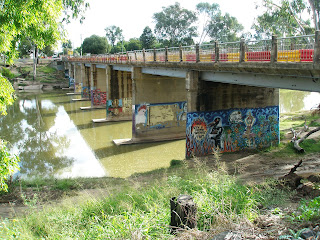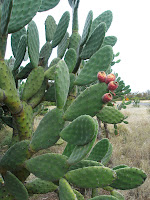Burketown, after being incommunicado for about 6 days:
We’ve had four blissful days
at Adel’s Grove, just outside the Boodjamulla (Lawn Hill) National Park.
After leaving Mount Isa we
drove as far as we could towards Adel’s Grove (north-west), and I had jokingly
said I wanted a bush camping spot beside a running river.
This was when we were
barrelling along a dusty road, with nothing but savannah beside us, but John
(also joking) said he’d find me such a spot.
 |
| John doing a photoshoot crossing of the O'Shannessy River. |
And then we came to it! The
O’Shannessy River, fairly close to Riversleigh fossil site, was just perfect.
It had pandanus and cabbage palms and huge old paperbarks. We were the only
ones there, and with its riverside of large river gravel it was unsuitable for anything but a 4WD. We
set up camp there and had an idyllic night listening to the sound of the river
rushing over some small rapids, and the ford by which we’d crossed it.
The next morning we crossed
the Gregory River, also very pretty but not as good as our campsite, and came
to Riversleigh fossil site. It has a wonderful instructive walk up and down the
hill topped with dramatic limestone and conglomerate, which tells the story of
the inland sea that once covered it. The pancake stack rocks are embedded with
tribolites (before creatures with backbones) but there was plenty of evidence
of them as well.
On then to Adel’s Grove. I’ll
explain the name. Albert de Lestang, a French botanist, bought the lease of
this land next to the Lawn Hill Creek in the 1930s, and it’s believed he was
commissioned by the Qld government of the day to experiment with growing
tropical trees and fruits. By 1939 he had more than 1000 different species of
trees and shrubs growing, many of them imported, and it was a beautiful botanic
garden, with seeds sent to Kew Gardens as well as the Qld Museum.
 |
| Lawn Hill Creek at Adel's Grove. |
In the early 1950s the Adel’s
Grove (named for his initials ( A de L) was accidentally burnt out from a fire
that escaped from one of the small mining ventures to the south. Albert was by
then in his 70s, had lost all his records, his buildings, and most of his
plantings, and went into a deep depression. He was taken to the Eventide home
in Charters Towers where he died in 1959.
Very little remains of his
plantings, just some mango trees, but the area beside the creek is very beautiful.
None of the sites in the
campground has power, but there are taps for water, so we have been very
comfortable with our solar panels and a generator.
 |
| Lawn Hill Gorge from one of the high spots to which we climbed |
One day we drove into
Boodjamulla National Park and went walking around the gorge. And of course we
tackled some of the steepest walks (I’d call them climbs!), going 200 metres
almost straight up for one magnificent view of the whole Lawn Hill Gorge.
Coming down was something else again, and we were grateful for our hiking sticks and boots. After lunch we tackled another walk, which proved almost equally as steep but the view from the top showed us a different part of the gorge. Spectacular! When we actually looked at our brochure about the national park walks, we found that the first one we’d tackled, the Island Stack, was rated as ‘difficult’. The 2nd one, the Duwadarri lookout, had a mention of ‘strenuous’. . . . so we really did get our exercise that day.
Coming down was something else again, and we were grateful for our hiking sticks and boots. After lunch we tackled another walk, which proved almost equally as steep but the view from the top showed us a different part of the gorge. Spectacular! When we actually looked at our brochure about the national park walks, we found that the first one we’d tackled, the Island Stack, was rated as ‘difficult’. The 2nd one, the Duwadarri lookout, had a mention of ‘strenuous’. . . . so we really did get our exercise that day.
The water in the creek is a
deep green from the limestone, so it’s quite gorgeous.
Luckily for our aching knees
and upper thighs (that’s from coming down the tracks made out of the stony
hillside), there was a resident masseuse at Adel’s Grove. She sets up camp
there from May to September each year, offers massages and also performs on
keyboards some nights during dinner at the restaurant.
I had 2 massages and John had
3, so we left in much better shape than when we arrived. She was very good and
found sore spots in my body I didn’t even know I had, apart from the
aforementioned knees and thighs.
We were tempted to go
kayaking on the creek at Adel’s Grove or in the gorge but with our dodgy backs
and knees, thought we’d leave it to the young families who’ve arrived in force
for the Qld school holidays.
The bird life at the
campground was prolific and as every site is separated from another by a screen
of foliage, we’ve had fantails, robins, wrens and wattle birds visiting and
even walking right up to us when we’re sitting outside admiring the sunset or
the beer/wine in our hands.
We left Adel’s Grove just
before an absolute invasion. The annual palaeontologists’ dig at Riversleigh
was about to start, plus 3 coach loads of tourists were expected, so there were
going to be at least 80 for dinner on several nights and 150 on the Sunday . .
. and that’s without any campers!
Extra tented cabins had been
organised and some of the ‘diggers’ were to be bunking in what had been an
activity room.
When we arrived at Burketown,
via Gregory Downs, where we had a drink at the pub in honour of Nigel (2nd
son, for the non-family members reading this blog) who’d won a canoeing event
there after a mad drive from Darwin when in the RAAF, we phoned ahead to book
into a caravan park at Karumba but found it’s high season and the first booking
is for Sunday.
It’s glorious here, shorts
and singlet weather, lots of trees, birds everywhere, so we will stay an extra
night, then take our time getting to Karumba, maybe doing some more bush
camping.
To say we’re relaxed and
happy would be an understatement. Just keep on working, get old enough to
retire, and you too can have this joy at seeing Australia!

.JPG)




















